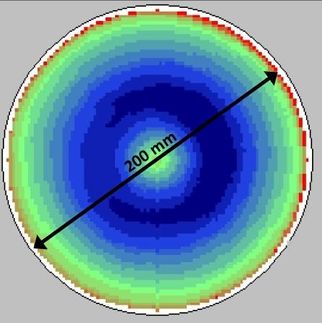Nanotechnology Goes Out on a Wing
Insect wings used to pattern nanoscale structures
What does a colorful and noisy backyard insect have to do with nanotechnology? Plenty, according to Jin Zhang and Zhongfan Liu, both professors at Peking University. A team of researchers led by Zhang and Liu have used the wings of cicadas, ubiquitous insects best known for their acoustic skills, as stamps to pattern polymer films with nanometer-sized structures. The wings of these insects are characterized by highly ordered arrays of closely spaced microscopic pillars. When these wings are pushed down upon a smooth polymer film, they create a negative imprint of the array pattern.
Zhang, Liu, and their co-workers from Peking University and Nanotechnology Industrialization Base of China have found that the insect wings possess sufficient rigidity and chemical stability and have a low enough surface tension to be used as stamps to pattern polymer films on silicon substrates. A low surface tension is necessary so that the wings do not stick to the substrate and can be released without destroying the imprinted structures.
Quite remarkably, the wings have a waxy coating, which imparts an intrinsically low surface tension to these structures, making them ideal for use as stamps. An ordered array of microscopic wells can be obtained on the polymer film by using the pillar array on the wings. This pattern can be transferred to silicon by an etching process, leading to the formation of 'nano-wells' on a silicon chip. Silicon wafers patterned with 'nano-wells' show promising anti-reflective properties. Arrays of microscopic gold pillars can also be obtained by using the imprinted molds. These pillar arrays are almost exact replicas of the structures found on the insect wings and may be useful for optical imaging or the detection of molecules by Raman spectroscopy.
"This technique is a powerful demonstration of how natural nanostructures existing in the environment can be used to pattern microscopic structures not easily accessible by conventional microfabrication technology", said Zhang. "There is a lot that nature can teach us about nanotechnology", added Liu, citing examples of butterfly wings and lotus leaves, which are characterized by exquisitely ordered arrays of microscale and nanoscale structures.
Original publication: J. Zhang et al.; "Cicada Wings: A Stamp from Nature for Nanoimprint Lithography"; Small 2006, 2, No. 12, 1440-1443.
Other news from the department science
Most read news
More news from our other portals
See the theme worlds for related content
Topic World Spectroscopy
Investigation with spectroscopy gives us unique insights into the composition and structure of materials. From UV-Vis spectroscopy to infrared and Raman spectroscopy to fluorescence and atomic absorption spectroscopy, spectroscopy offers us a wide range of analytical techniques to precisely characterize substances. Immerse yourself in the fascinating world of spectroscopy!

Topic World Spectroscopy
Investigation with spectroscopy gives us unique insights into the composition and structure of materials. From UV-Vis spectroscopy to infrared and Raman spectroscopy to fluorescence and atomic absorption spectroscopy, spectroscopy offers us a wide range of analytical techniques to precisely characterize substances. Immerse yourself in the fascinating world of spectroscopy!






























































